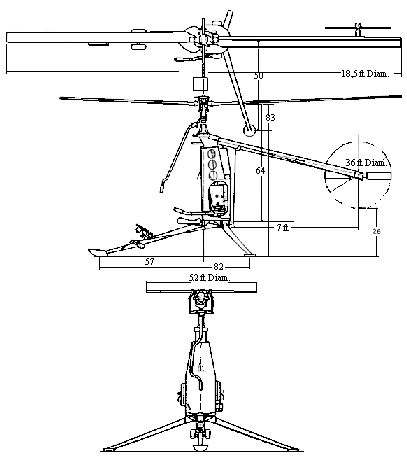
""
HILLER
HELICOPTERS INC.
|
HILLER
ROE-1 |


|
|
|
En
1953, la U.S. Navy en nombre del U. S. Marine Corps, anuncia una
competencia para diseñar y construir un helicóptero de una sola plaza,
que pudiese utilizarse para dejarlo caer detrás de las líneas enemigas
y así poder auto-rescatarse los pilotos en emergencia. Compiten 30
firmas por este contrato, pero la Marina selecciona a solo dos, a la
Hiller Aircraft Company y a la Gyrodyne Company of America. La Marina
juzga que el diseño del Gyrodyne YRON-1 (con dos rotores
coaxiales) es impracticable. Posteriormente adopta este concepto para el
Drone Anti-Submarine Helicopter (DASH). En
1954 la Hiller Helicopters fue seleccionada por la Oficina de la Marina
de los EE.UU. para construir el helicóptero de una sola plaza, el
Hiller Modelo 1033, que fue designado por los militares como el
XROE-1 "Rotorcycle" . Se construyen primeramente
dos prototipos en la planta de Hiller en Palo Alto, California. Constaba
de un rotor principal con dos “remos”, el famoso Hiller Rotormatic,
con un rotor de cola convencional. La potencia estaba provista por un
motor de cuatro cilindros Nelson H-59, de dos tiempos y 40 hp de
potencia refrigerados por aire. El primer prototipo voló por primera
vez el 10 de enero de 1957. Saunders
Roe, un constructor inglés de aeronaves, fue contratado para construir
otros diez Rotorcycles. En total se construyeron doce ejemplares.
El modelo inglés voló por primera vez en octubre de 1959 y los
primeros cinco aparatos fueron terminados para la primavera de 1960 con
el segundo lote de cinco para diciembre de 1961. Cinco de los helicópteros
Saunders Roe fueron enviados a EE.UU. para ser evaluados por los
militares, con la designación “YROE-1”, y los otros cinco
permanecieron en Europa en Helicop-Air de París, el agente de ventas
civil de Hiller en Europa. Los helicópteros Saunders Roe tenían la
designación civil de Modelo G-46. Siete
Rotorcycles finalizaron su carrera en los EE.UU.; los dos
prototipos de Hiller con la designación de XROE-1 y los 5 de
Saunders Roe con la designación YROE-1. Los BuAer 4021,
4020 and 4024 (Los BuAer son números dados por la Oficina Naval de USA.
Todas las aeronaves adquiridas por el US Navy o el US Marine Corps
tienen números BuAer) fueron evaluados por la NASA, en noviembre de
1962. Los BuAer 4023 y 4024 fueron evaluados por el U.S. Marines Corps. El
Rotorcycle nunca entré en servicio militar debido a que los
requerimientos fueron cancelados una vez finalizadas las pruebas. |
|
|
|
In 1953, the U. S. Navy, on
behalf of the U. S. Marine Corps, announced a competition to design and
build a one-man helicopter. Thirty
firms competed for the contract, but the Navy selected only two, the
Hiller Aircraft Company and the Gyrodyne Company of America. The
Marine's judged Gyrodyne's YRON-1 design (with twin, coaxial,
main rotor) impractical for one-man operation. Later, the Navy adopted
this concept as the Drone Anti-Submarine Helicopter (DASH) and
several of these rotorcraft operated from destroyers with decks too
small to mount helipads. In1954 Hiller Helicopters
was selected by the Navy's Bureau of Aeronautics to build a one man,
foldable, self-rescue and observation helicopter. The Hiller Model 1033
was designated by the military as the XROE-1 "Rotorcycle" .
Two prototypes were built at the Hiller Helicopter Plant in Palo Alto,
California. The helicopter has the Hiller Rotormatic control
paddles with a conventional tail rotor. Power was supplied from a Nelson
H-59, two cycle, 40 hp, four cylinder opposed air cooled engine through
a centrifugal clutch. The prototype Rotorcycle first flew on January 10,
1957. Saunders Roe, an English
aircraft manufacturer, was contracted to build ten additional Rotorcycles.
Twelve Rotorcycles were built in all. The English built helicopter first
flew in October 1959, the first five were completed by the spring of
1960 with a second lot of five completed by December 1961. Five of the
Saunders Roe helicopters were shipped back to the U.S. for military
evaluation (with the designation "YROE-1"), the
remaining five license built aircraft stayed in Europe at Helicop-Air of
Paris, the European Hiller civilian sales agent. The Saunders Roe
helicopters had a civilian designation of Model G-46. Seven of the Rotorcycles
ended their careers in the United States; the two Hiller Helicopter
prototype Rotocycles with the XROE-1 designation and the 5
Saunders Roe Rotocycles designated as YROE-1. BuAer 4021,
4020 and 4024 (BuAer numbers are issued by the US Naval Bureau of
Aeronautics. All aircraft acquired for the US Navy or the US
Marine Corps are issued a BuAer number) were evaluated at NASA Ames
Moffett Field, CA in November 1962. BuAer 4023 & 4024 were
evaluated at Patuxent River, MD for the U.S. Marines Corps. |
|
|
|
Characteristics |
Information |
Characteristics |
Information |
| First
Flight Primer Vuelo |
1957 |
Engine Motor |
1 Nelson |
| Seating
Capacity Plazas |
1 |
Power Potencia |
40 HP |
| Empty
Weight Peso Vacío |
300 Lb |
Hover
Ceiling O.G.E. Estacionario O.G.E |
6400 Ft |
| Maximum
Weight Peso Máximo |
496 Lb |
Hover
Ceiling I.G.E. Estacionario I.G.E |
9200 Ft |
| Vel.
Cruise Vel. crucero |
40 Kts |
Service
Ceiling Techo de Servicio |
13200 Ft |
| V.N.E. V.N.E |
57 Kts |
Maximum
Range (Std) Alcance (Std) |
140 NM |
|
Dimensions / Dimensiones |
|||
| Total
Length Largo Total |
18,50 ft |
Main
Rotor Diameter Rotor Princ. Diámetro |
18,50 ft |
| Total
Height Alto Total |
0,92 ft |
Tail
Rotor Diameter Diam. Rotor de Cola |
3,6 ft |
Copyright © 1999 / 2003